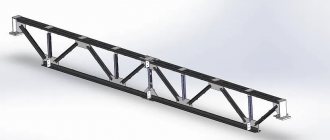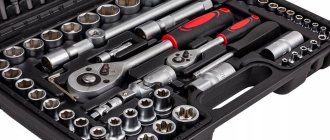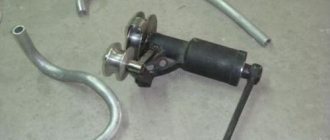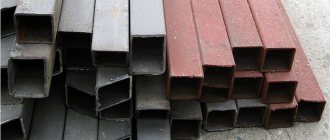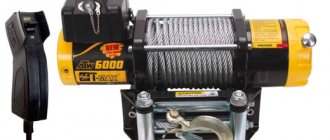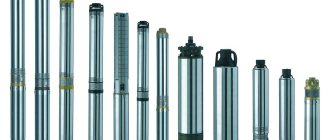Good day to all! For many motorists, a trailer has become an indispensable means of transporting construction materials, crops from the dacha, furniture and other objects. But the standard dimensions of this trailed vehicle are not always enough to transport certain elements. Therefore, a trailer drawbar extension becomes a way out of this situation.
The drawbar is widely used for transporting long cargo if its length exceeds 5-6 meters. Conventional trailers make it possible to transport the same boards if their length does not go beyond 5-6 meters.
For longer loads, you will need to use an extension cord to comply with traffic regulations and also to ensure the safety of the load itself.
Varieties
First, look at the equipment of the trailer you purchased. There are examples when an extension cord is included with the vehicle.
A good example is the Kurgan Trailers company, where the presence of an extension cord is a standard feature of their products.
Owners of a variety of caravans may need an extension cord, including:
- SST;
- SAZ;
- Vector Love;
- Batyr;
- Trailer;
- MZSA;
- KMZ 8136;
- Strong, etc.
There are separate materials about many of these brands on our website. Just go to the section with passenger trailers, or use the convenient field to search for information.
I think each of you understands why a motorist might need such auxiliary elements.
Therefore, our main task now is to choose the appropriate option, having understood the varieties and some of the nuances.
In fact, extension cords differ in their purpose and manufacturing features. Don't forget about the dimensional characteristics and materials used.
Classification by manufacture
Essentially, a motorist has two main options. This is to buy a structure that complements the main trailer, or to assemble it yourself.
I’ll say right away that the second option is not the best idea. Yes, structurally it can be an ordinary pipe with several holes. But even here there are some nuances and manufacturing features that can only be implemented in specialized production conditions.
If you want your passenger trailer to operate equally safely and reliably with or without an extension, choose factory-made products. In addition, many manufacturers offer the required designs as spare parts, and some, like Kurgan Trailers, standardly equip their trailer models with them. It turns out that you won’t have to look for anything, saw or drill anything. You just need to purchase a finished product and install it on the vehicle according to the manufacturer’s instructions.
Yes, some people successfully assemble extension cords with their own hands for their own car trailer. But here you will need to calculate the length, take into account the changing load, compare it with the load capacity and other characteristics.
Roughly speaking, you won’t be able to weld the first pipe you come across. This can have serious consequences.
By purpose
Based on their purpose, such products can also be divided into 2 subcategories.
People choose between them quite often, although objectively only one of the two options will be the most correct.
Universal . These are extensions that, in theory, fit a wide variety of caravan models. Versatility has both its advantages and disadvantages. A conflict between the parameters of the device and the trailer itself can provoke a sudden breakdown, violation of the integrity of the product, or destruction of connections. Many universal models are not made in the best way in terms of design and materials used. Therefore, I would advise you to abandon this idea.
The only exceptions are those situations when it is simply impossible to purchase the second option.
In general, I have a negative opinion of universal accessories for passenger caravans. In my experience, I have encountered many frankly low-grade products.
Yes, in theory they are suitable for a large number of trailers. But in practice everything is not so simple. Poor quality metal, connection holes that do not correspond to the trailer, the need to make additional holes in the metal, etc.
How to lengthen the drawbar of a passenger trailer with your own hands?
Today, many companies produce trailers for transporting long loads. Each specimen on the market has its own positive qualities. Moreover, the lineup is so large that it is sometimes difficult to understand how to make a choice.
About long lengths in simple words
Long loads are loads whose dimensions exceed the dimensions of the vehicle in length. This includes loads that protrude beyond the platform by more than 0.5 meters. This includes profiled sheets: plastic, metal, polymer, or lumber. Rails, poles, rolled materials, parts of large machines.
Some types of rolled metal, communication line supports, reinforced concrete slabs or pipeline components. Transportation of this type of material is carried out during various types of construction, installation work or laying power lines, for example. It requires a lot of space to accommodate it, so standard trailed equipment is unlikely to be suitable.
Long-length vehicles are also called vehicles designed for transporting this type of cargo.
Types of trailers for transporting long items
Trailers for transporting long loads are distinguished:
- By number of axles:
- Uniaxial samples. When transporting long items using a single-axle trailer, owners often have difficulty placing the center of gravity. Transporting long items on a single-axle trailer
- Biaxial. The priority, of course, is dual-axle. They are more stable and can have a load capacity even twice as large as their single-axle counterparts.
- With or without drawbar extension.
The drawbar extension is based on a metal profile with a square cross-section. There are two types of drawbar: triangular and straight. You can lengthen both, but the A-shaped drawbar wins in this regard. This is due to the fact that the load on the connection nodes due to its geometry is much lower, and the structure itself is more load-bearing. Heavy Duty 500 ATV LAKER trailer with triangular drawbar - With folding sides, removable or not. Manufacturers often equip their products with front and rear folding sides, thereby increasing the length of the floor of the towed unit. Often there are trailers that transform into a platform with removable sides. The floor area is smaller than with folding ones, but is suitable for the stated purposes. And devices that are not equipped with any of the functions are unsuitable for transporting long loads.
- In addition to flatbed and platform trailers, you can find frame trailers on the market. They do not protect the load from dirt well when moving, but they are also useful for this purpose.
- Trailed vehicles vary in size and size. It happens that in some cases a standard drop-side trailer is sufficient. But today's manufacturer offers a rich model range with increased dimensions.
- It is worth noting that there is a difference in the configuration. Some samples are equipped directly from the factory with additional optics, a drawbar extension, a support wheel, a parking brake (although it is required for long lengths), and rigging loops for securing loads.
Ways to extend a trailer
There are only two ways to extend a trailer using:
- Trailer frame modifications.
Namely, by lengthening the side members using welding and metalwork. Quite a labor-intensive and costly process. Extending the frame frame on a trailer with your own hands - Drawbar extension.
Here you have a choice: purchase a factory device that has a guarantee of reliability, or make it yourself. Factory units are inexpensive and not difficult to install. Extension of the drawbar on the MZSA trailer
Review of the best trailers for transporting long items
The most popular brands of trailers for transporting oversized cargo are: MZSA, Vector, Trailer, Kurgan trailers, Batyr, Laker.
- Trailer MZSA 817732.012. Biaxial unit. Body dimensions - 3.449x1.511x0.29, dimensions - 4.794x1.992x0.848 meters. Its gross weight is 0.75 and its load capacity is 0.412 tons. Loading height – 557 mm. It is equipped with a spring suspension, a triangular drawbar, a moisture-resistant bottom made of laminated plywood, and galvanized folding sides. Price – 73,200 rubles.
- MZSA 817735.012. Gross weight 0.75, load capacity 0.329 tons. The dimensions of the device are 5.990x1.992x0.908, body dimensions are 4.597x1.511x0.29 meters. Loading height – 617 millimeters. The permissible length of the load is 600 centimeters. Equipped with rigging eyes, a reinforced hitch head, folding sides and a triangular drawbar. Price – 90,000 rubles.
- Laker Heavy Duty 500 Triangle Drawbar Trailer. Gross weight – 0.75, load capacity – 0.54 tons. Dimensions - 4.4x2x0.76, body dimensions - 3.22x1.5x0.04 meters. Loading height – 470 millimeters. It is equipped with spring or rubber-harness suspension, a high-quality wooden bottom, a hinged tailgate, and plastic wings. Powder coated. Intended for universal use: transportation of ATVs, boats, and other cargo. Price – 39,900 rubles. Trailer Laker Heavy Duty 500
- Batyr Long - has an extended cargo platform for transporting goods of 4.7 meters. Gross weight – 0.75, load capacity – 0.53 tons. Dimensions – 4.70x1.97x0.860 body dimensions – 3.440x1.50x0.30 meters. And the platform area is 5 square meters. It is equipped with a triangular drawbar and spring suspension with springs, galvanized sides, and one axle. Can be equipped with an awning. Price – 50,700 rubles.
- Kurgan station wagon trailer 8213-05 from - single axle with enlarged sides. Capable of transporting long items with a pre-installed drawbar extension. Gross weight – 0.75, load capacity – 0.55 tons. Dimensions - 3.555x1.71x0.98, body dimensions - 2.38x1.22x0.38 meters. Suspension type: spring. Moisture-resistant sides and bottom made of laminated plywood. The basic package includes a drawbar extension. Price – 45,000 rubles.
Rules for the transportation of oversized cargo
For passenger car trailers, the law prohibits the transportation of oversized cargo exceeding 5.5 meters in length, including the drawbar.
And also the Traffic Rules establish the permissible standard load on the ball, which should be about 25-30 kilograms.
At the same time, the maximum speed when transporting long items, depending on the road surface, is: 60 km/h - on asphalt, 40 - on a hard-surface road, 20 - on a dirt road.
video about transporting long cargo
Advantages and disadvantages
- Load capacity. Trailers for long vehicles are usually designed with a reinforced structure and on two axles.
- Versatility. In addition to long loads, such trailed equipment allows you to transport any other loads, including floating vessels.
- Large size. An oversized trailer or one with an extended drawbar is difficult to place, requiring sufficient space in the garage.
- Increased weight of the device. An increase in size inevitably leads to weight, and this affects the ease of use in general.
- Instability of uniaxial units. On single-axle trailers, the center of gravity is too difficult to achieve.
Recently, the development of industry and construction has been accelerating. In this regard, transportation of oversized cargo using a passenger trailer has become popular. Transportation of long items requires careful preparation and is a rather labor-intensive process. Therefore, it requires a clear approach and measured actions, including when choosing a trailer.
Review of passenger trailers for transporting long cargo Link to main publication
Do-it-yourself trailer extension - Metalworker's Guide
Today, many companies produce trailers for transporting long loads. Each specimen on the market has its own positive qualities. Moreover, the lineup is so large that it is sometimes difficult to understand how to make a choice.
DIY car trailer
Sometimes the trunk capacity of a passenger car is not roomy enough for many motorists, especially if transportation of large cargo is required. A trailer is best suited to solve this problem.
Homemade trailers for cars
There are two types of trailers, manufactured by a specialized factory or home-made:
- Factory trailers do not require additional permits for their registration and registration. But at the same time, factory trailers do not always satisfy car enthusiasts with their technical characteristics, and if they do, their price is prohibitively high. And the quality of the trailers themselves is not at a high level, which requires additional investments after purchase to eliminate factory defects.
- A homemade trailer is a structure that a car enthusiast assembles according to his own drawing from a material that makes it obsolete in quality, while adhering to GOST standards for its assembly. As for the registration aspects of such a product, they are much more expensive than when registering a factory one, since additional permits are required to operate a homemade trailer.
If we look at it from an economic point of view, the cost of a homemade trailer, taking into account all registration costs, is significantly lower than buying a new one.
It is also worth considering that a homemade trailer will be of much higher quality than a factory one, if only because the entire manufacturing process will be controlled by the car enthusiast himself.
Set of tools and materials
The first thing you need to make your own trailer is a drawing.
It is also worth noting that the drawing must comply with GOST standards 37.001.220-80 .
This standard specifies all the requirements that are necessary in order to obtain permission to operate a trailer and its further registration in the Interdistrict Registration and Examination Department.
In addition to the drawing, the following materials will be required to make a homemade trailer.
- Profile pipe 40x40 millimeters for constructing a trailer frame. You can use a larger pipe, but it is worth considering that this will entail an increase in the weight of the structure.
- For the sides, it is recommended to use steel sheets with a thickness of at least 0.6 millimeters , but not more than 1 mm, as this can also lead to an unnecessary increase in the weight of the sight.
- For the bottom of the trailer, you can use OSB sheets or polycarbonate. The amount of material is calculated from the bottom area of the trailer.
- Metal beam 80x5 mm for the trailer axle.
- Hub for mounting wheels , perfect for the rear beam of the VAZ 2108.
- Two VAZ wheels with a diameter of R 13 , R14 upon request.
- Two shock absorbers from a Ural motorcycle.
- Two automobile shock-absorbing springs, you can use a building from a VAZ 2101 or a ZAZ 969.
- Two-core braided wire for electrical wiring, approximately 10 meters.
- Parking headlights with stops and turns.
- A thick-walled metal pipe at least three meters long. For the manufacture of a towing element.
- Towbar lock.
- Male-male connector for connecting the on-board network from the car.
DIY trailer
How to make a trailer for a car with your own hands and what tools are needed when creating this type of “accessory” for a car?
On this page you will learn how to make a trailer for your iron horse with your own hands. We will definitely tell you what you will need for this, looking ahead, I will tell you that nothing supernatural is required, an ordinary tool such as an angle grinder, a screwdriver, an electric jigsaw, etc. Also pipes for the frame and much more that can be easily found at any construction site.
And upon completion of the manufacture of the trailer, you will learn how and where to register the trailer with the traffic police.
:
Sometimes, to solve the problem of lack of space in the trunk, the best option is to make a homemade trailer for a car with your own hands .
Even if the cargo you need to transport is not heavy, its dimensions may become an obstacle to normal placement in the trunk of your car.
It is clear that there are different types of cars, and there are enough models with large and spacious luggage compartments, but now we are taking into account middle-class passenger cars, the percentage of which is the highest on our roads.
Technical implementation of extending the overall dimensions of a trailer
Regardless of whether the car enthusiast will do this on his own or delegate the work to specialists, you need to think about a technical solution to this problem.
The length of the drawbar may vary, but it is necessary to determine whether it will be folding or solid. A long trailer is more cumbersome to drive, so it is optimal if it can be extended as needed.
You will need to think about the folding and fastening mechanism, so such a project will cost more.
The next point that needs to be considered with a trailer on a passenger car is how the drawbar will be attached: using welding or bolts. If you make a completely new drawbar, then the old one is completely removed.
As an alternative, an additional fragment of a durable metal profile is welded to the old one. The length of such a drawbar may be different, but it is desirable that the new part be identical in width and thickness.
It is important to carefully select the material from which the elongated structure will be made. Of course, it must be moderately durable and withstand significant loads.
It is better not to use flat metal elements for extensions, which simply may turn out to be weak.
Experts recommend purchasing a metal corner or channel with a thickness of at least 3 mm.
Once you have measured how much additional length will be added, you need to take care of reinforcing the structure. To do this, a corner is welded perpendicular to the flange on both sides.
All work to lengthen the drawbar can take at least several hours, because you will have to weld and attach metal bolts, as well as treat them with anti-corrosion compounds. Everyone determines the length calculation for themselves.
Commercially available extension cords are capable of transporting loads up to 5.5-6 meters in length.
How to lengthen the tongue of a passenger trailer
If the driver wants to carry out work on extending the drawbar of a passenger trailer on his own, then he will have to stock up on some tools and materials. First of all, this is an angle grinder and a drill, adjustable and gas wrenches, a welding machine, a metal angle (channel), bolts and nuts, sealing materials, and anti-corrosion mixtures.
You can purchase a ready-made drawbar extension for a light vehicle trailer. They are produced by factories in the form of pipes with dimensions of 40x80 or 40x60 mm. Such a drawbar can change position and extend the distance from the trailer to the car by 2 positions: 40 or 80 cm. The sequence of actions for installing it will be something like this:
- the old coupling device is removed;
- the half-drawbar mount on the trailer is removed;
- the extension cord is placed in the place provided for this and tightened with bolts;
- The half-drawbar can be returned to its original place.
In order to carry out this procedure, it is necessary to prepare certain spare parts. In addition to the extension cord itself and the half-drawbar, you will need a lock retainer and a fastening bracket, as well as a lock with a handle.
Now let's see how you can lengthen the drawbar in a professional way, that is, the way it would be done at a service station. This procedure does not require much time and includes the following steps:
- The first step is to remove the coupling head from the trailer tongue. To do this you will need a 19 key.
- To dismantle the half-drawbar, you will have to unscrew the side brackets. The trailer tips over on its side.
- Using a 19mm wrench, unscrew the corresponding drawbar mount, which secures it to the frame of the trailer itself.
- Now the same is done for the other side of the trailer and the half-drawbar.
- The mounting bushings on the coupling head are removed.
- Now the installation of the extension cord begins - you need to find 2 holes on it. The coupling head will be inserted into the one located at the front. The extension cord itself is inserted into the drawbar with the opposite end. The holes allow you to adjust the length of the coupling structure.
- Once the length is selected, the hole on the extension is aligned with the same one on the drawbar. A half-drawbar is attached to the trailer frame.
- There are 2 mounting holes on the front of the drawbar into which you need to insert bolts and tighten them.
The wire may not be long enough to connect the trailer optics (lighting devices). To do this, you need to remove the clamps from the harness and pull it out to the missing distance. Now you can reinstall the clamps and return the trailer to its original position. All that remains is to install the coupling head in its place, and the trailer is ready to transport long and bulky cargo.
According to existing transportation rules, the length of transported goods should not exceed 5.5 meters in length. Long items must be moved so that they do not drag along the road or get into the trunk of the car itself. To do this, the distance from it to the trailer must be extended using any of the methods described above.
Advice: in parallel with the extension work, experienced travelers immediately install updated LED optics, which are more economical in themselves.
Don’t forget about reflectors - this is safety for all road users. A worn-out awning is replaced with a new one or a plastic roof is installed instead.
It would be a good idea to cover the trailer body itself with a new paint coating instead of the worn out old one.
Do-it-yourself modification of a trailer for a passenger car: possible options
Hello, friends! Since a factory trailer cannot always fully satisfy the needs of its owner, many decide to make structural changes to the vehicle. All possible modifications to the trailer are aimed at achieving those characteristics that will suit you.
But what can be created from it and how much can trailers be modified? Let's talk about this.
Legality of modernization
I will not talk specifically about how to do this or that tuning. Is it possible to change the design at all? This is the first question that needs to be answered.
Drawbar design features
Today we can highlight a number of excellent examples of trailers that are used every day by both trucks and cars. Reliability, as well as high performance characteristics of these devices, largely depend on a high-quality drawbar.
For example, we can distinguish the following towed devices:
- Sturdy;
- MZSA;
- SZAP;
- KAMAZ;
- NEFAZ, etc.
These trailers are truly popular throughout the CIS and beyond. Their popularity is due not to the work of the advertising department, but to the quality of workmanship, as well as assembly, in which the coupling mechanism, in other words, the drawbar, plays an important role.
What types of drawbar are there?
Today on trailers you can see the following drawbar options:
- I-shaped drawbar;
- V-shaped drawbar (triangular shape). Sometimes it is also called A-shaped, which in principle is also correct.
The drawbar may also have additional elements such as safety ropes, as well as folding stands, but not all trailer models have them. They are mainly necessary for ease of use of the device, as well as for a more reliable connection.
Let's take a closer look at them:
- Hitch unit. It is also called a castle. It is used as a connecting element to the vehicle's tow bar. Depending on the trailer hitch, the connection can be made using hinges, bushings, pins, ball joints, etc. Don’t forget about the locking device, which is secured with a special lever. This device is necessary in order to firmly hold the knot in the ball. Some coupling units have a special indicator that shows how worn it is, as well as a device that allows you to change the gaps between the coupling balls and the cup;
- Safety ropes (chains) are used as insurance in case of possible detachment of the trailer from the vehicle. This can happen if the coupling unit fails;
- The folding stand allows you to store the detached trailer in a horizontal position. There are also stands that allow you to adjust the height of the lock. This is an additional option that is used when using a trailer, the structure of which is much lower than that of a car. For example, to attach to an SUV.
Before purchasing a towbar, you need to pay attention to the drawbar, and also take into account the operating conditions of the towbar.
- I-shaped drawbar is perfect for a single-axle device coupled to a passenger car. It is used in the case of transporting small loads, most often for household needs;
- V-shaped drawbar is designed for transporting medium-heavy loads. It prevents rocking of the device, as well as the coupling mechanism itself, in case of movement on a nervous road surface;
- The extended V-shaped drawbar is used for transporting heavy loads. It is rarely used in domestic conditions, but for transporting boats, motorcycles, ATVs, water scooters or other vehicles, this is just the thing.
Advantages of V-drawbar
The most important advantages of this type of drawbar should be noted:
- The V-shaped drawbar is attached in several places, which increases the safety of movement. Reliable fastening prevents possible swinging;
- It can be equipped with a special extension cord, which significantly increases the possibilities of using the device. The extension cord allows you to transport long types of cargo, for example, pipes, boards and much more;
- One of the advantages of a V-shaped drawbar is the fact that it can serve as a place for a spare tire, thereby freeing up space in the trunk of the car. Also, when traveling long distances with a trailer, you can have two spare tires at once;
- Tipper types of trailers are always equipped with only a V-shaped drawbar, as this is required by design features.
Many people claim that riding and maneuvering with an I-bar is much easier compared to a V-bar, but in reality, it's just a matter of habit.
The bottom line is that a V-shaped drawbar is far superior to a drawbar with an I-shaped design. It is safer, more reliable, and also easier to use, but decide for yourself which option to choose.
Here you can evaluate the author's work:
Algorithm for lengthening the drawbar of a car trailer
Domestic car enthusiasts have long appreciated the new opportunities that a passenger car equipped with a trailer can provide.
With its help, you can transport household utensils, construction equipment and materials, furniture over any distance at a time that suits you.
However, for transporting long cargo, such as pipes or a boat, the standard trailer length is not enough. The solution in such a situation may be to lengthen the drawbar of the towbar.
Extend the drawbar on a light trailer
Transportation of long lumber is one of the most difficult tasks for specialists in the field of cargo delivery. To accomplish the task, special vehicles are required. For individuals and small companies interested in transporting boards and timber, special light trailers are provided. They involve comfortable loading, unloading and transportation of such materials.
Lumber includes:
- boards;
- beam;
- chipboard;
- Fiberboard;
- veneer.
Lumber stacked in the trailer is securely fixed
The process of loading long cargo into a passenger trailer begins with opening the front and rear sides. Next, the lumber is laid in a strict order: the longest are placed on the bottom, the shortest on top.
However, stowing the load in a certain way is half the battle. An important part of transporting cargo is its reliable securing. You can secure the load with tie-down straps. First, the boards are tied together, and then they need to be pulled tightly to the bottom of the body.
This method of securing will help the load not to move around the trailer on the road.
If the boards protrude beyond the trailer, the load must be marked. For this purpose, a special sign “Large cargo” with white and red stripes is used. The sign is attached to the part of the boards and beams that protrude outward.
Traffic regulations regulate the transportation of oversized lumber. Firstly, the load should not impair the driver's visibility. Secondly, the stability of the loaded vehicle must not be compromised. Thirdly, boards and timber should not interfere with traffic, litter the environment or create noise.
It is recommended to load and unload a passenger trailer in less busy areas, having previously fenced off the work area. For greater safety, experienced drivers transport this kind of cargo along roads with low traffic flow.
Remember – the safety of all road users and the safety of the cargo depend on compliance with the basic rules.
To transport boards, timber and lumber in general, it is necessary that the trailer be equipped with folding rear and front sides. This simplifies the process of loading and unloading the body.
Also, models on two axles are more stable, which is especially important when transporting oversized cargo (boards, timber and other lumber).
If the trailer is designed for transporting bulk materials, fishing trips and trips out of town, i.e.
Boat trailer: design features, which one to choose
Model . These are those designs that fit a factory drawbar of a certain configuration. It is important to understand that caravan manufacturers use literally several basic options of drawbar, which are mounted on different models of trailers. This allows you to use one template to assemble a large number of products. Therefore, identical extensions are offered for the same drawbar from the same manufacturer. The models are made in full accordance with the dimensions and holes for the use of these accessories.
As you understand, I fully and completely support model versions of products in this case.
If you have a different opinion, be sure to write about it in the comments and give reasons. We will certainly discuss this issue and come to certain conclusions.
Material, coating and condition
Drawbar extensions, presented in the form of a pipe with certain dimensional characteristics, are usually made of steel.
Legality of modernization
I will not talk specifically about how to do this or that tuning. Is it possible to change the design at all? This is the first question that needs to be answered.
I'll say this. Some changes may not require any adjustments to your documents. But radical tuning will potentially become the subject of disputes with road service employees.
Therefore, before turning your regular car trailer into a camper or using it as a motor home, seek advice from the traffic police.
Tuning requires obtaining appropriate certificates of changes in the design of the vehicle. You will have to go through a number of offices, pay state fees, stand in lines, etc.
Although many simply ignore it. They modernize the trailer the way they want, and on the spot with the traffic police officers they find out how legal it is and how to circumvent such prohibitions. If you want to get rid of unnecessary traffic stops and incomprehensible fines, go through the lengthy but legal procedure of re-registering a trailer. This is the best option, in my opinion.
Well, or instead of converting it to a PVC boat, immediately buy yourself a trailer designed and certified specifically for such purposes. Remodeling is a troublesome task, although it is always nice to see the results of work done with your own hands.
